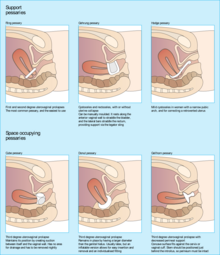User:Barbara (WVS)/sandboxdyk
A pessary is a prosthetic device inserted into the vagina to reduce the protrusion of pelvic structures into the vagina. It can be a route of administration of medication and provides a slow and consistent release of the medication. Pessaries are of varying shapes and sizes. They may cause vaginal ulceration if they are not correctly sized and routinely cleansed. Depending on locale, pessaries can be fitted by health care practitioners; in some countries, pessaries may be available over the counter.[1]
The term is derived from Ancient Greek: πεσσάριον, romanized: pessárion, "a piece of medication-soaked wool/lint, inserted into the vagina."[2] Sears, Roebuck & Co. previously sold pessaries through their catalog. [3]

Types of pessaries
[edit]
Therapeutic pessaries
[edit]A therapeutic pessary is a medical device similar to the outer ring of a diaphragm. Therapeutic pessaries are used to support the uterus, vagina, bladder, or rectum. Pessaries are a treatment option for pelvic organ prolapse.[4] A pessary is most commonly used to treat prolapse of the uterus. It is also used to treat stress urinary incontinence, a retroverted uterus, cystocele and rectocele. Historically, pessaries may have also been used to perform abortions.
The Cerclage Pessary is used to treat pregnant women with cervical incompetence in order to support the cervix and turn it backward towards the sacrum. It may be indicated in pregnancies with a history of premature labor, multiple pregnancies or mothers who are exposed to physical strain (e.g. standing for a long time). It may also be indicated in pregnant women suffering from prolapse of the genital organs.[5]
The pessary can be placed temporarily or permanently, and must be fitted by a physician, physician assistant, midwife, or advanced practice nurse. Some pessaries can be worn during intercourse.
Pharmaceutical pessaries
[edit]A pharmaceutical pessary is used as a very effective means of delivery of pharmaceutical substances easily absorbed through the skin of the vagina, or intended to have action in the locality, for example against inflammation or yeast infection, or on the uterus. A prostaglandin pessary is used to induce labor.[6]
Occlusive pessaries
[edit]An occlusive pessary is generally used in combination with spermicide as a contraceptive.
Stem pessary
[edit]The stem pessary, a type of occlusive pessary, was an early form of the cervical cap. Shaped like a dome, it covered the cervix, and a central rod or "stem" entered the uterus through the os, to hold it in place.[7]
General side effects
[edit]Side effects that are shared among most different types of pessaries include: risks of increased vaginal discharge, vaginal irritation, ulceration, bleeding, and dyspareunia (painful intercourse for the male or female).
History
[edit]During the 1800's, the US Patent office did not allow patents to be obtained for preventing pregnancy. Instead such devices were registered as pessaries though the term was understood to mean a device to 'hold the womb in place'. Some of the models, such as those sold by Sears and Roebuck were bulky and provided contraception because intercourse was impossible with the pessary in place.[8][9][10] Physicians of the time were critical of the pessary because of the potential of infection and advised their female patients to refrain from intercouse when the pessary was being used.[11]
See also
[edit]References
[edit]- ^ "Cystoceles, Urethroceles, Enteroceles, and Rectoceles - Gynecology and Obstetrics - Merck Manuals Professional Edition". Merck Manuals Professional Edition. Retrieved 2017-12-29.
- ^ http://dictionary.reference.com/browse/pessary?s=t
- ^ Mitchell, Siri (2010-04-01). She Walks in Beauty. Bethany House. ISBN 9781441207579. Retrieved December 31, 2017.
- ^ American Urogynecologic Society (May 5, 2015), "Five Things Physicians and Patients Should Question", Choosing Wisely: an initiative of the ABIM Foundation, American Urogynecologic Society, retrieved June 1, 2015, which cites: * Culligan, PJ (April 2012). "Nonsurgical management of pelvic organ prolapse". Obstetrics and Gynecology. 119 (4): 852–60. doi:10.1097/aog.0b013e31824c0806. PMID 22433350. S2CID 21218937.
- ACOG Committee on Practice, Bulletins--Gynecology (September 2007). "ACOG Practice Bulletin No. 85: Pelvic organ prolapse". Obstetrics and Gynecology. 110 (3): 717–29. doi:10.1097/01.aog.0000263925.97887.72. PMID 17766624..
- ^ "Archived copy". Archived from the original on 2016-03-24. Retrieved 2016-03-11.
{{cite web}}: CS1 maint: archived copy as title (link) - ^ Tiran, Denise (2012-07-25). Bailliere's Midwives' Dictionary E-Book. Elsevier Health Sciences. ISBN 9780702046797.
- ^ Contraceptive Stem Pessary in Aluminium
- ^ Stanley, Autumn (1995). Mothers and Daughters of Invention: Notes for a Revised History of Technology. Rutgers University Press. ISBN 9780813521978.
- ^ Burgess, Susan; Leeman, Kate (2016-03-11). CQ Press Guide to Radical Politics in the United States. CQ Press. ISBN 9781506354705.
- ^ Guarding Life's Dark Secrets: Legal and Social Controls over Reputation, Propriety, and Privacy. Stanford University Press. 2007. ISBN 9780804763219.
- ^ Dunster, Edward Swift; Hunter, James Bradbridge; Sajous, Charles Euchariste de Medicis; Foster, Frank Pierce; Stragnell, Gregory; Klaunberg, Henry J.; Martí-Ibáñez, Félix (1919). International Record of Medicine and General Practice Clinics. MD Publications.






